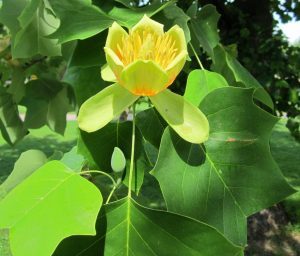Quality, Service, & Forest Stewardship for Over 100 years!
Pike News
Yellow Poplar – The Indiana State Tree

Yellow Poplar is one of the tallest, most scenic trees growing in the hardwood forests of the Midwestern United States. There is a good possibility you have some of these trees growing in your woods. Following are some interesting facts about this tree. Yellow Poplar – scientific name: Liriodendron tulipifera- is commonly referred to as “Poplar”, “Tulip Tree” and “Tulip Poplar”. The term “tulip” is used to describe this tree because it flowers in the spring and the flower resembles a tulip flower.
The bark is a grayish color and becomes thicker as the tree ages. Its leaves are large and to the untrained eye can resemble the leaves of Sugar Maple trees. Yellow Poplar requires ample sunlight to grow. If the tree is receiving adequate sunlight and is growing in rich, moist, well-drained soils it can grow at approximately twice the rate of some of the Oak species. Yellow Poplar trees often times represent the biggest trees growing in the woods reaching heights of 150 feet and diameters exceeding 4 feet. They generally have straight trunks. Because of the size and straightness often found in Poplar logs, it is no wonder why the pioneers preferred this timber for log cabin construction.
It is also highly rot resistant, which is why many barns were sided in the last couple centuries with Poplar lumber. Yellow Poplar lumber is most commonly sold as “Poplar”. It is widely produced in the Eastern United States and is generally one of the lower valued types of lumber available in the hardwood market. But don’t let its value fool you. It is a versatile, highly machinable light weight lumber with many applications ranging from interior mouldings, doors, furniture parts, musical instruments and cabinetry. Poplar lumber can show many colors including green, tan, white, purple, black and brown. This color variation detracts from its value as an appearance wood.
Its grain is considered less desirable than most other commercial hardwood species. In most products, Poplar is either painted or receives a dark stain to create the look of a more valuable wood such as Cherry or Maple. It is one of the less dense hardwood species so it does not hold up well to abuse.
Pike Lumber Company is certainly an interested buyer of Yellow Poplar timber. Harvesting larger Yellow Poplar trees is often times a successful method of helping you manage your forestland by allowing more sunlight to reach the younger trees growing in the forest’s understory.